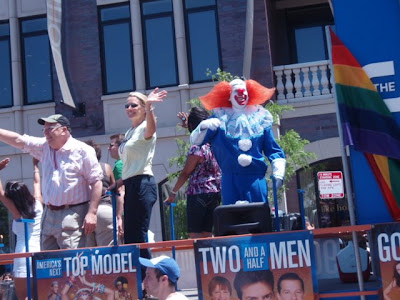Last weekend at Chicago's Printer's Row Book Fair (or, excuse me, Mayor Daley's "Lit Fest") I had the pleasure of seeing cartoonists Chris Ware and Lynda Barry in conversation. Lynda was absolutely hilarious-- there's nothing as funny as seeing an outspoken middle-aged lady making jokes about everything from turkeys to testicles. Also my friend Kirsten had a class with her, so I expected her to be the brilliant woman that she was. I, however, went to see the talk because of Chris Ware, who was in the background the entire time but one of the most fascinating artists I've ever encountered. While Lynda Barry made the audience fall in love with her wackiness, Chris Ware talked about how he never had friends as a child, how life sucks, how relationships suck, how he hates speaking in public. Blonde, eyeglassed, protruding forehead and all, I have never heard anyone so honest about the reality of life, and how utterly disappointing it is.
Chris Ware often does covers of the New Yorker, and you might recognize his particular comic book style: simple, geometric figures, snapshots of the everyday lives of people, zeroing in on how miserable and terrible life is for everyone. He described it in one of his books as "schadenfreude," but I don't really buy it... the reader doesn't feel a delight in the misery of others, but more of an endearing camaraderie. That "I'm not alone in what I feel"-ness. This is especially evident in his "Acme Novelty Library" series, in which he inspects a few days in the lives of 7 or 8 characters, in varying times in their lives, interacting with each other on occasion, shifting between various points of view. I think we can't help but find a character we feel a kinship with. For some reason I was quite fond of a lonely brunette amputee living in Chicago, worrying about her weight and so intensely wanting in love that she messes it up completely. I forget her name, but she works in a flower shop, and originally went to art school before hating its pretentiousness. A pretty familiar tale, I think, among a lot of my friends.
Of course I didn't say all of this to Chris Ware when I met him. When I went to get my book signed, I blubbered out, "So, er, where do you get your characters from?" which isn't only an imbecilic question but completely bad grammar (ending interrogative sentences with a preposition? ew). Then I continued in this gross middle-school vein by asking, "'Cause, um, some of them sure do resemble you..." He definitely had to stifle a snort after this one, smirking a bit and trying to avoid the question. And of course I heard him speak without reading most of his series. I read the entire series a week later, and whadya know, he even
names one of the characters Chris Ware, and he's a slightly lecherous and extremely pretentious art teacher in a public school in Omaha (his hometown). Question answered. I was so embarassed that I almost pulled the Ivy League card, which I tend to do whenever my intelligence is questioned. This is how I rewrote the conversation in my head: "Oh by the way, I go to Columbia University. You know, the Ivy League. You know, in the top ten schools in the United States. Oh, and my GPA happens to be freakin' fantastic. Want to grab a drink and co-author a paper with me? Totally platonic, scout's honor. We can even get Art Spiegelman in on the deal." Oh, a girl can dream.
What I love about Chris Ware has less to do with his artwork-- which is still quite beautiful and idiosyncratic-- but his genre-bending success. He is somewhere between a writer and an artist, and I was completely inspired by his work. His graphic novels are listed in the fiction part of the library, but I first heard of him when I saw his "Jimmy Corrigan" exhibit at the Museum of Contemporary Art in Chicago (still my favorite museum in the United States). I forget what else I stammered out when getting my book signed (in shaky, but still near-typed-perfect drafting script), but it must have been something about my separate and equal love of art and literature, because he asked which one came first. I said, "Well, neither, really. I think they came about at the same time," which is 100% true, but he seemed not to believe me. Oh well.
In any case, Chris Ware is now (one of) my favorite artist(s) and will henceforth graze the walls of my summer cubicle. I'm convinced if anyone reads a Chris Ware comic, they'll get me. Period. One hundred percent. It's also inspiring to have an artist so famous living in Oak Park, of all places. Not Manhattan. Not even Lincoln Park, or an equally prestigious Chicago neighborhood. Instead, a slumbery Northwest suburb. It's almost... sweet.

This is a comic about my favorite character, the lonely amputee girl mentioned above:















 This is a comic about my favorite character, the lonely amputee girl mentioned above:
This is a comic about my favorite character, the lonely amputee girl mentioned above:
